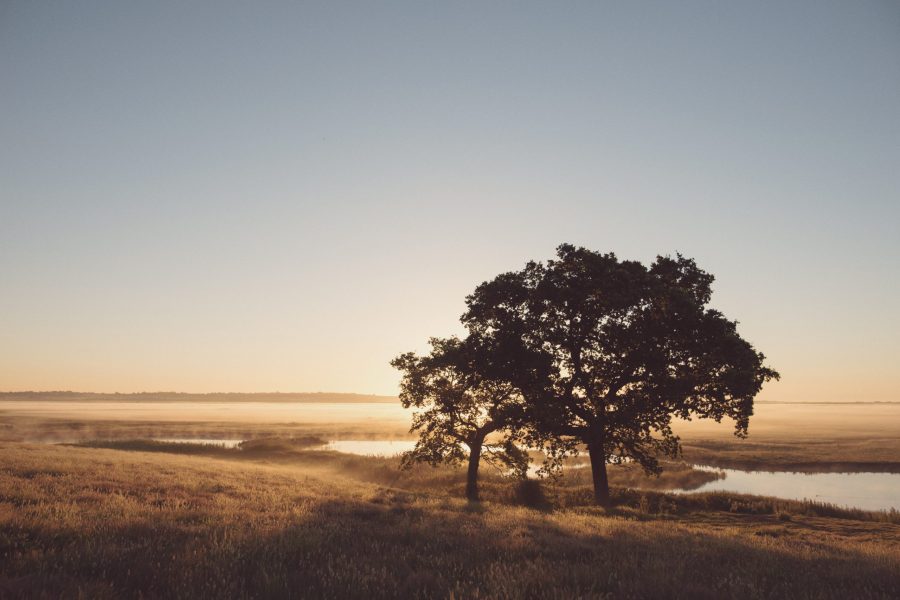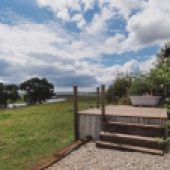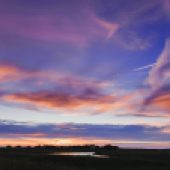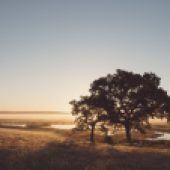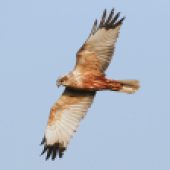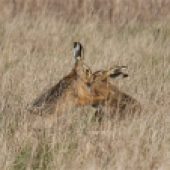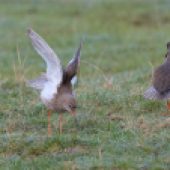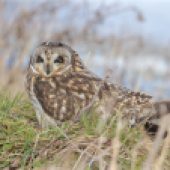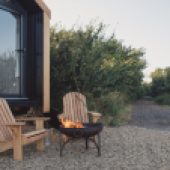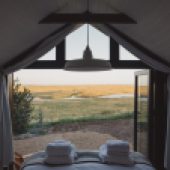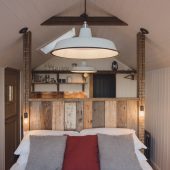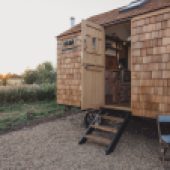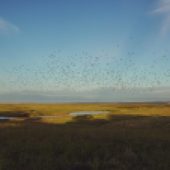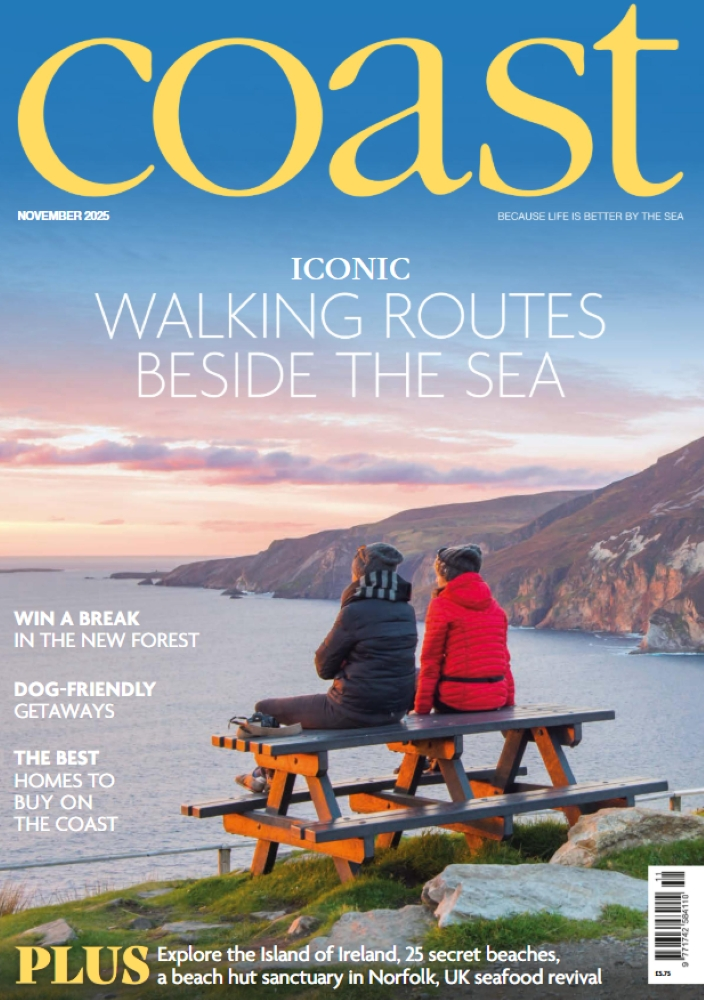A location where hares run free across the marshes and migrating birds babble, Elmley Nature Reserve on Kent’s north coast is a place of tranquility, whether you visit for a day’s discovery or stay overnight in a chichi shepherd’s hut
Words CAROLINE WHEATER Photographs REBECCA DOUGLAS, ROBERT CANIS AND SULA REIDLINGER
A nother late autumn day dawns at Elmley Nature Reserve and spectral ribbons of mist hang over the ditches and waterways that irrigate this unique coastal marshland habitat. At around 8am, a skein of resident greylag geese, flying in a V-shape, rise up from their watery overnight quarters to go foraging in a field, while large flocks of mallard and pintail ducks bustle about. The 3,200-acre estate, which is both a national nature reserve and a working farm, is on the eastern side of the Isle of Sheppey, where the Thames Estuary meets the English Channel. Overlooking the sheltered Swale Channel and its mudflats, Elmley is a safe haven for wildlife of all kinds, from wildfowl and waders, to hares and water voles, to insects and invertebrates.
In November, the vegetation on the freshwater grazing marsh and its saltwater marsh fringe is short and green, inviting to the whimbrels and green sandpipers that refuel en route to Africa. ‘This is a quiet time at the reserve, a changeover period before our full complement of migrating waders and wildfowl arrive to overwinter on the land and water bodies. It’s a rich feeding table,’ says Gareth Fulton, reserve manager and son-in-law of farmers Philip and Corinne Merricks who have been at Kingshill Farm for over 40 years – the only farming family in the country to own and run a national nature reserve.
THE BIG ARRIVAL
Come January, Elmley will have filled with around 40,000 babbling birds, three-quarters of which are migratory. Vast flocks of wigeon – 10,000 strong – along with teal, lapwing, golden plover, curlews, redshanks and brent geese fly in from the Arctic and northern Europe. The colder it is, the earlier they arrive. With the visitors come aerobatic predators including short-eared owls, peregrine falcons, and sprite-like merlins that seasonally relocate from the UK’s northern moors for more abundant southerly pickings by the seaside.
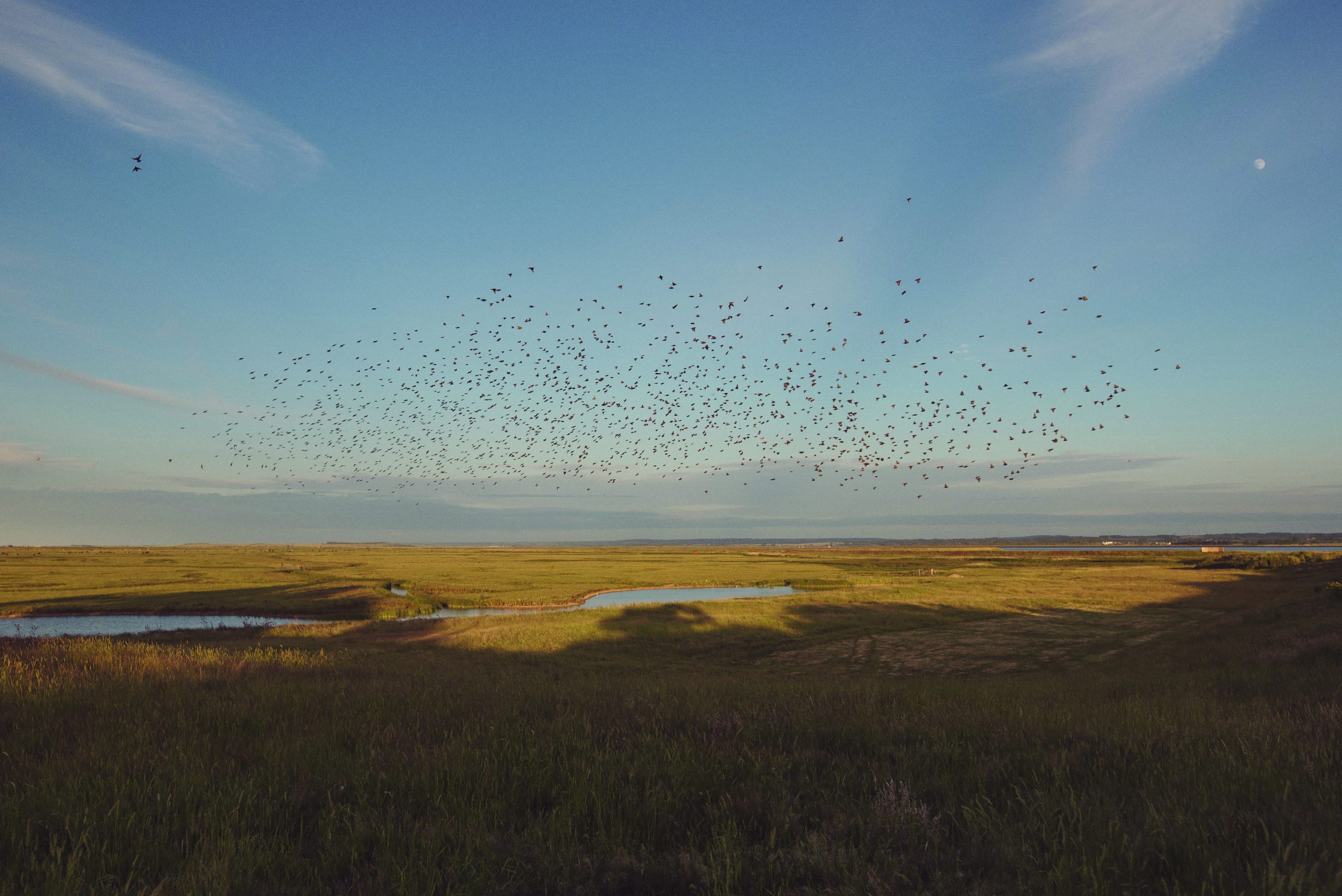
Marsh harriers are the reserve’s star raptor and 12 breeding pairs live there permanently, joined at the winter table by many more – 160 of these beady-eyed birds were recorded last year, quite an achievement for a species that was near extinction in the 1970s. Four hides on the estate ensure that human visitors can watch the daily avian antics with ease. ‘Elmley is known to be one of South East England’s best places to see birds of prey in the wild,’ says Gareth. He adds that his favourite hide is remote Spitend on the edge of the salt marsh fringe, a five-kilometre walk from the farmhouse, with views out to the dark blue sea.
CONSERVATION MATTERS
Not only is Elmley a site of special scientific interest (SSSI), it also has Ramsar status and is classified as a wetland of global importance. ‘By scale, the Thames Estuary is the biggest migratory stopping off point in the South East,’ explains Gareth, ‘and Elmley and the wider Swale ranks as the 15th most important site in the UK.’ The responsibility of looking after the reserve, in conjunction with Natural England, is taken very seriously by the Merricks and their daughter Georgina who moved here with Gareth in 2013 to help take the farm forward. ‘No chemicals have been used on the marsh for 50 years and as a consequence there’s an abundance of insect life – in autumn the mist settles on the thousands of spiders’ webs spun all over the marsh,’ Gareth says. It is also off-grid, with power generated by a solar array.
Careful management has made the reserve a stronghold for brown hares and water voles. ‘We see hares every day, sometimes they nibble the flowers in our garden!’ says Gareth. It’s not lost on them what a privilege this is, watching hares grazing on grass and wildflowers, dozing in their forms (little dips in the ground where they sleep), boxing in March for dominance, and looking after their leverets in the summer sunshine. Water voles are harder to spot, but just as busy.
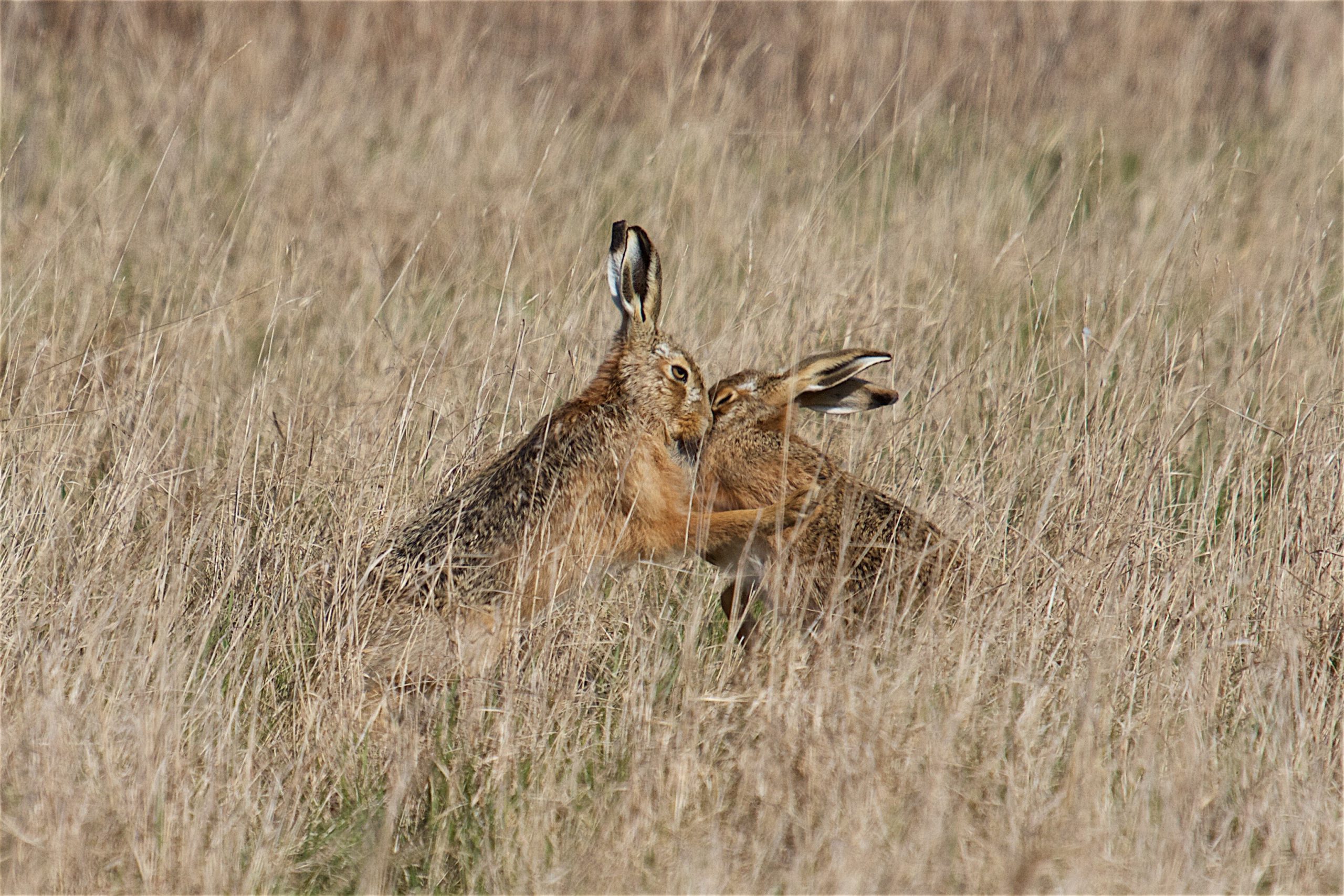
To support Elmley’s biodiversity, water levels are carefully controlled and ditches monitored by Gareth and his team, which includes local volunteers. ‘We need a range of different aged ditches to make a variety of habitats, so some are three or four years old [since being cleared of silt], others are in their teens, others are over 20 years old.’ A suckler herd of 800 beef cattle help provide high quality food for the flocks because they ‘rip’ rather than nibble at the grass, which creates variety in the sward, allowing all sorts of wee beasties and aquatic wildflowers such as fleabane and water-crowfoot to thrive. The cattle are in residence from Easter to Christmas, and then from December to February 1,000 Romney Marsh sheep tidy up what’s left. In March the birds start to set up for breeding so the livestock is moved on.
STAY IN A LUXURY SHEPHERD'S HUT
You can see all this action and more by spending a morning or a day at the reserve. There are guided tours to join and plenty of paths to potter along independently – take a packed lunch, a pair of binoculars and make an outing of it. Alternatively, Kingshill Farm offers a wilderness escape like no other, and is the only national nature reserve where you can stay overnight. This was an initiative driven by Gareth and Georgina. ‘When we arrived in 2013 to help diversify the business we knew birders would come here but we wanted to bring a new audience to conservation, so we introduced some hand-crafted shepherd’s huts for people to stay in. Guests come for a complete switch-off – the huts are widely spaced and all look east across the Swale Channel towards Whitstable so you feel like you’re in your own little world,’ says Gareth.
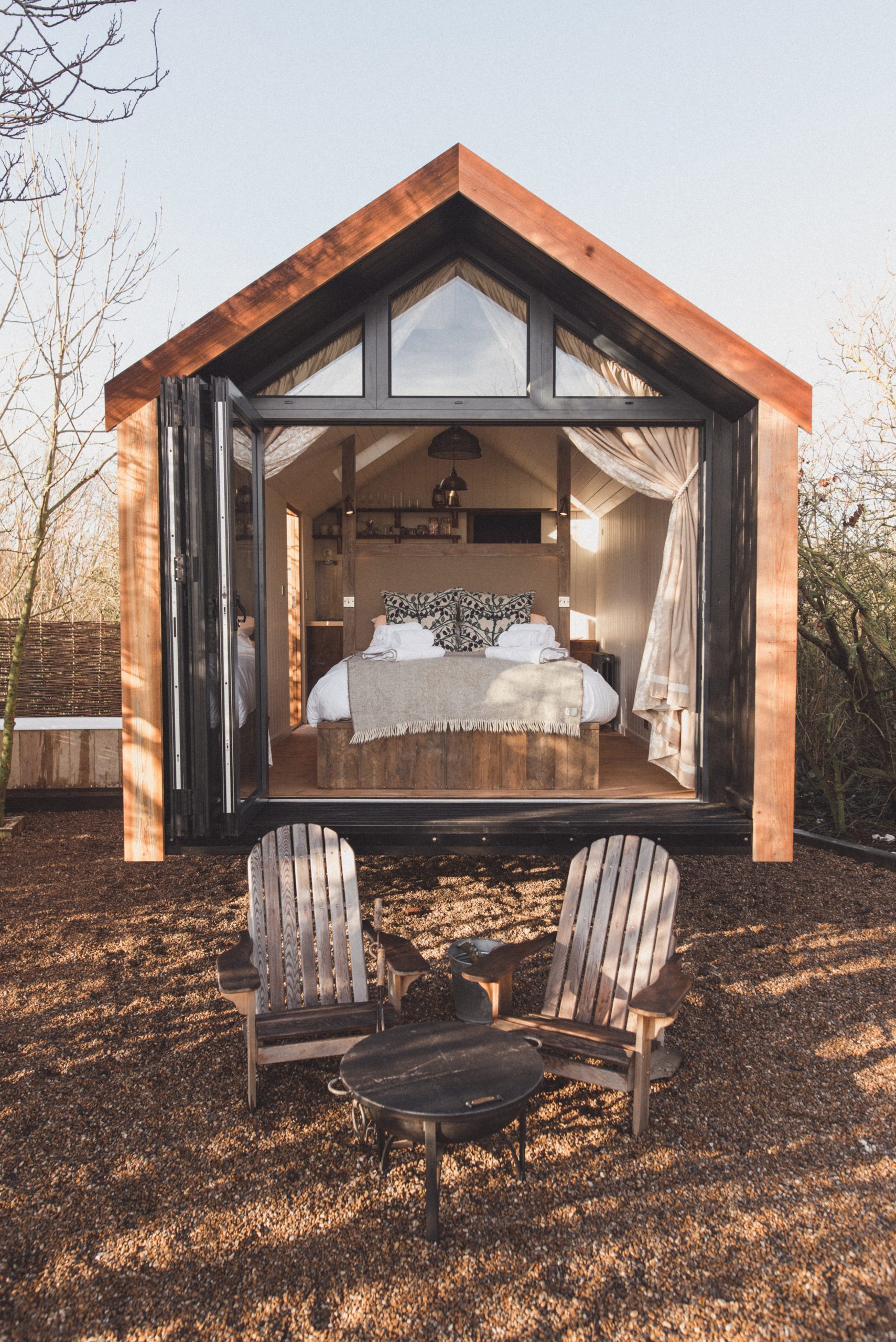
Elmley is just an hour’s train journey from London and once you’re there everything is provided, should you want it, from a hot breakfast to a two-course evening meal. Relaxation is a byword and each hut has a pair of Adirondack chairs and a fire pit to sit by in the evening, little extras such as marshmallows to roast are provided. Guests spend time walking, sitting on private Cockleshell Beach in the summer months, reading, and just watching life go by. Says Gareth: ‘In winter the soundscape is a babble of ducks and geese quacking, in summer you hear the hum of insects and the sea breezes blowing through the reeds. Being on the Thames Estuary, sometimes you hear the honk of a shipping horn – that’s all part of this place. It’s so atmospheric and so full of wildlife.’
For more information on visiting, go to elmleynaturereserve.co.uk
STAYING AT THE RESERVE
PLEASE CHECK GOVERNMENT RESTRICTIONS BEFORE TRAVELLING
• Kingshill Farm on Elmley Nature Reserve is open to guests all year round and offers several types of accommodation, from bell tents in high summer to permanent shepherd’s huts with en suite bathrooms, plus a cottage and a farmhouse to sleep bigger parties – all with fantastic views across the marshes. In the popular huts you can cater for yourself using the basic cooking equipment provided. Or forget all about cooking and order up a hot bacon or halloumi sandwich (£8.50pp) with a cafetière of coffee for breakfast; while in the evening the two-course set supper menu changes daily (£22pp). Packed lunches are also available. Wellbeing treatments such as massage can be booked as an extra. Prices for a two-person shepherd’s hut (Little Owl and Samphire) start at £115 per night (01795 664896, elmleynaturereserve.co.uk).
• The nearest station to Elmley is Swale on the Sheerness line. From London Victoria, St Pancras and Stratford International, go direct to Sittingbourne, change for Swale or get a taxi (15 minutes’ drive).
A location where hares run free across the marshes and migrating birds babble, Elmley Nature Reserve on Kent’s north coast is a place of tranquility, whether you visit for a day’s discovery or stay overnight in a chichi shepherd’s hut
Words CAROLINE WHEATER Photographs REBECCA DOUGLAS, ROBERT CANIS AND SULA REIDLINGER
A nother late autumn day dawns at Elmley Nature Reserve and spectral ribbons of mist hang over the ditches and waterways that irrigate this unique coastal marshland habitat. At around 8am, a skein of resident greylag geese, flying in a V-shape, rise up from their watery overnight quarters to go foraging in a field, while large flocks of mallard and pintail ducks bustle about. The 3,200-acre estate, which is both a national nature reserve and a working farm, is on the eastern side of the Isle of Sheppey, where the Thames Estuary meets the English Channel. Overlooking the sheltered Swale Channel and its mudflats, Elmley is a safe haven for wildlife of all kinds, from wildfowl and waders, to hares and water voles, to insects and invertebrates.
In November, the vegetation on the freshwater grazing marsh and its saltwater marsh fringe is short and green, inviting to the whimbrels and green sandpipers that refuel en route to Africa. ‘This is a quiet time at the reserve, a changeover period before our full complement of migrating waders and wildfowl arrive to overwinter on the land and water bodies. It’s a rich feeding table,’ says Gareth Fulton, reserve manager and son-in-law of farmers Philip and Corinne Merricks who have been at Kingshill Farm for over 40 years – the only farming family in the country to own and run a national nature reserve.
THE BIG ARRIVAL
Come January, Elmley will have filled with around 40,000 babbling birds, three-quarters of which are migratory. Vast flocks of wigeon – 10,000 strong – along with teal, lapwing, golden plover, curlews, redshanks and brent geese fly in from the Arctic and northern Europe. The colder it is, the earlier they arrive. With the visitors come aerobatic predators including short-eared owls, peregrine falcons, and sprite-like merlins that seasonally relocate from the UK’s northern moors for more abundant southerly pickings by the seaside.

Marsh harriers are the reserve’s star raptor and 12 breeding pairs live there permanently, joined at the winter table by many more – 160 of these beady-eyed birds were recorded last year, quite an achievement for a species that was near extinction in the 1970s. Four hides on the estate ensure that human visitors can watch the daily avian antics with ease. ‘Elmley is known to be one of South East England’s best places to see birds of prey in the wild,’ says Gareth. He adds that his favourite hide is remote Spitend on the edge of the salt marsh fringe, a five-kilometre walk from the farmhouse, with views out to the dark blue sea.
CONSERVATION MATTERS
Not only is Elmley a site of special scientific interest (SSSI), it also has Ramsar status and is classified as a wetland of global importance. ‘By scale, the Thames Estuary is the biggest migratory stopping off point in the South East,’ explains Gareth, ‘and Elmley and the wider Swale ranks as the 15th most important site in the UK.’ The responsibility of looking after the reserve, in conjunction with Natural England, is taken very seriously by the Merricks and their daughter Georgina who moved here with Gareth in 2013 to help take the farm forward. ‘No chemicals have been used on the marsh for 50 years and as a consequence there’s an abundance of insect life – in autumn the mist settles on the thousands of spiders’ webs spun all over the marsh,’ Gareth says. It is also off-grid, with power generated by a solar array.
Careful management has made the reserve a stronghold for brown hares and water voles. ‘We see hares every day, sometimes they nibble the flowers in our garden!’ says Gareth. It’s not lost on them what a privilege this is, watching hares grazing on grass and wildflowers, dozing in their forms (little dips in the ground where they sleep), boxing in March for dominance, and looking after their leverets in the summer sunshine. Water voles are harder to spot, but just as busy.

To support Elmley’s biodiversity, water levels are carefully controlled and ditches monitored by Gareth and his team, which includes local volunteers. ‘We need a range of different aged ditches to make a variety of habitats, so some are three or four years old [since being cleared of silt], others are in their teens, others are over 20 years old.’ A suckler herd of 800 beef cattle help provide high quality food for the flocks because they ‘rip’ rather than nibble at the grass, which creates variety in the sward, allowing all sorts of wee beasties and aquatic wildflowers such as fleabane and water-crowfoot to thrive. The cattle are in residence from Easter to Christmas, and then from December to February 1,000 Romney Marsh sheep tidy up what’s left. In March the birds start to set up for breeding so the livestock is moved on.
STAY IN A LUXURY SHEPHERD'S HUT
You can see all this action and more by spending a morning or a day at the reserve. There are guided tours to join and plenty of paths to potter along independently – take a packed lunch, a pair of binoculars and make an outing of it. Alternatively, Kingshill Farm offers a wilderness escape like no other, and is the only national nature reserve where you can stay overnight. This was an initiative driven by Gareth and Georgina. ‘When we arrived in 2013 to help diversify the business we knew birders would come here but we wanted to bring a new audience to conservation, so we introduced some hand-crafted shepherd’s huts for people to stay in. Guests come for a complete switch-off – the huts are widely spaced and all look east across the Swale Channel towards Whitstable so you feel like you’re in your own little world,’ says Gareth.

Elmley is just an hour’s train journey from London and once you’re there everything is provided, should you want it, from a hot breakfast to a two-course evening meal. Relaxation is a byword and each hut has a pair of Adirondack chairs and a fire pit to sit by in the evening, little extras such as marshmallows to roast are provided. Guests spend time walking, sitting on private Cockleshell Beach in the summer months, reading, and just watching life go by. Says Gareth: ‘In winter the soundscape is a babble of ducks and geese quacking, in summer you hear the hum of insects and the sea breezes blowing through the reeds. Being on the Thames Estuary, sometimes you hear the honk of a shipping horn – that’s all part of this place. It’s so atmospheric and so full of wildlife.’
For more information on visiting, go to elmleynaturereserve.co.uk
STAYING AT THE RESERVE
PLEASE CHECK GOVERNMENT RESTRICTIONS BEFORE TRAVELLING
• Kingshill Farm on Elmley Nature Reserve is open to guests all year round and offers several types of accommodation, from bell tents in high summer to permanent shepherd’s huts with en suite bathrooms, plus a cottage and a farmhouse to sleep bigger parties – all with fantastic views across the marshes. In the popular huts you can cater for yourself using the basic cooking equipment provided. Or forget all about cooking and order up a hot bacon or halloumi sandwich (£8.50pp) with a cafetière of coffee for breakfast; while in the evening the two-course set supper menu changes daily (£22pp). Packed lunches are also available. Wellbeing treatments such as massage can be booked as an extra. Prices for a two-person shepherd’s hut (Little Owl and Samphire) start at £115 per night (01795 664896, elmleynaturereserve.co.uk).
• The nearest station to Elmley is Swale on the Sheerness line. From London Victoria, St Pancras and Stratford International, go direct to Sittingbourne, change for Swale or get a taxi (15 minutes’ drive).

